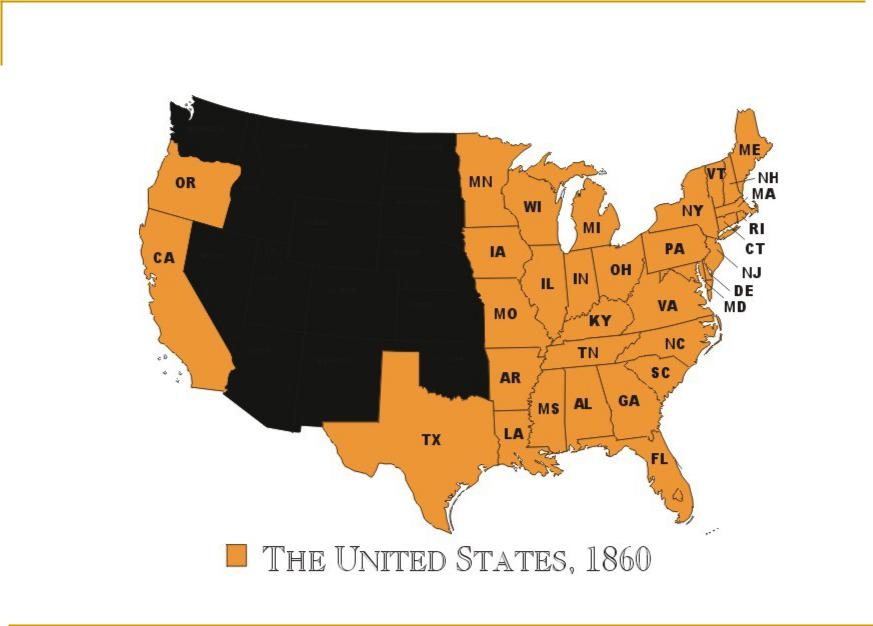
- •The Civil War and
- •Secession
- •"Confiscation Acts"
- •"War of Northern Aggression" or "War Among the States."
- •Master of Retreat
- •Civil War - 1863-1865
- •Gettysburg
- •Reconstruction
- •Embarrassing History
- •The "Gilded Age"
- •Rockefeller
- •American Dream enacted
- •Workers’ Rights
- •Indian Matter
- •Preparing for the "Turn of the Century"
- •Other Social Themes

The Civil War and
After-War Years
1861 - 1900


Secession
In 1860, the South threatened to secede (break away) from the United States if the Republican Abraham Lincoln were elected president.
By the end of January 1861, six other southern states imitated South Carolina and declared their independence from the United States. They were Mississippi, Florida, Alabama, Georgia, Louisiana and Texas. "We are divorced, North and South, because we have hated each other so."

"Confiscation Acts"
1861 - authorized the Union to seize any property, including slaves, which were being used to aid the South in its "insurrection" against the North
The Second Confiscation Act was next passed in 1862, taking the additional step of ordering freedom for any slaves belonging to slave-owners engaged in "treason" against the United States.

"War of Northern Aggression" or "War Among the States."
The eleven states - Confederate States of America
Constitution
president (Jefferson Davis)
capitol city (Montgomery, Alabama) money, the "Confederate Flag,"
Bull Run, Virginia, on July 21.186. The North defeated; D.C. – not taken.

Master of Retreat
My Dear McClellan:
If you are not using the army, I should like to borrow it for a short while.
Yours respectfully, Abraham Lincoln

Civil War - 1863-1865
On January 1, 1863, Lincoln issued the
Emancipation Proclamation. This historic document proclaimed all slaves in areas in rebellion to be "forever free."
July 4, 1863 in two different locations: Gettysburg, Pennsylvania (July 1-3) and Vicksburg, Mississippi (July 4). The losses of the South on those days have been described as "mortal blows."
Ulysses S. Grant
geographically that had the huge impact of cutting the South in half.

Gettysburg
The Union side (the "Army of the Potomac" in this case) had 83,289 men; the Confederate Soldiers (the "Army of Northern Virginia") totaled 75,054 men: 10,000 soldiers killed, 30,000 wounded, and another 10,000 captured or missing; more Confederate soldiers were killed and wounded than Union soldiers.
"Gettysburg Address" : Lincoln's short speech ends with "that this nation, under God, shall have a new birth of freedom -- and that government of the people, by the people, for the people, shall not perish from the earth."

1864-1865
"March to the Sea" in late 1864
"Southern Disunion“
The terms of surrender were generous to the South:
Good Friday, April 14th, Lincoln assassinated by John Wilkes Booth
Congress controlled by the "Radical Republicans"

Reconstruction
the 12-year period from the end of the Civil War (1865) to 1877;
Civil Rights Act of 1866 to establish the rights of blacks to testify in court, make contracts, and hold property
"carpetbaggers"
Reconstruction Amendments, all of which were added to the U.S. Constitution in the five years following the Civil War (1865-1870):
13th Amendments: abolish slavery
14th Amendment: give all races equal rights 15th Amendment: give all races the right to vote
